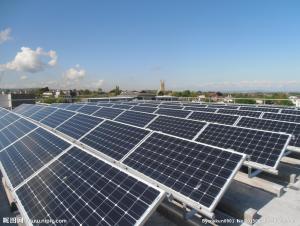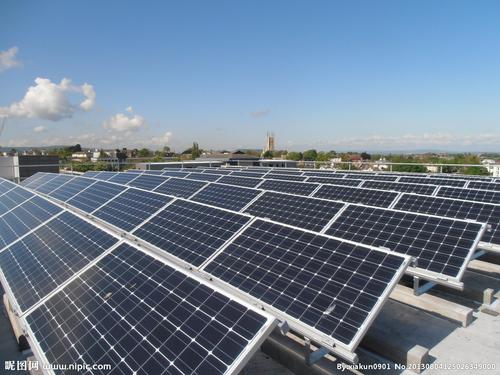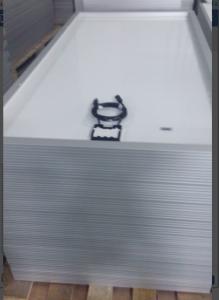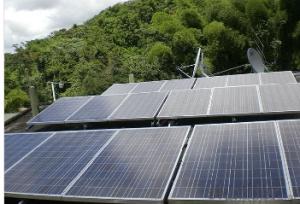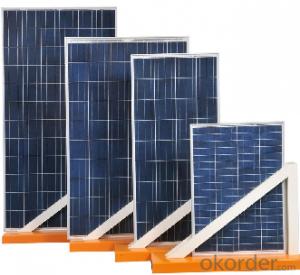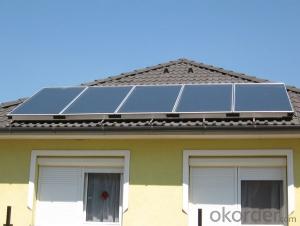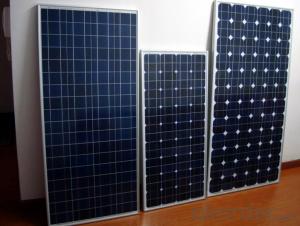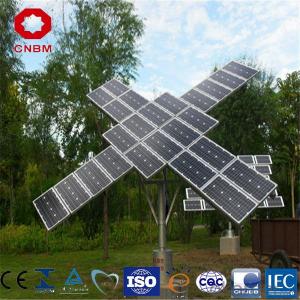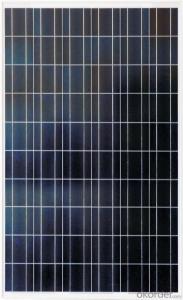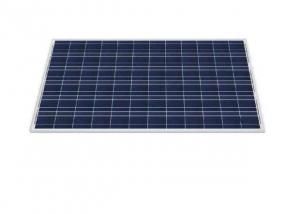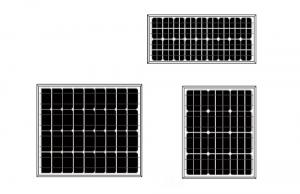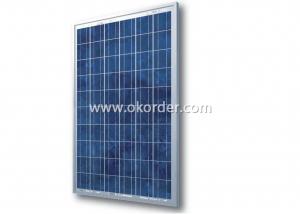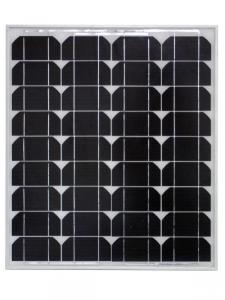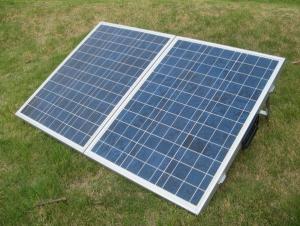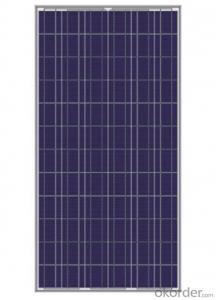Portable Solar Panels for Renters - Solar Module Poly 255W
- Loading Port:
- China Main Port
- Payment Terms:
- TT OR LC
- Min Order Qty:
- -
- Supply Capability:
- -
OKorder Service Pledge
OKorder Financial Service
You Might Also Like
Solar Module
ABOUT YINGLI GREEN ENERGY
Yingli Green Energy Holding Company Limited (NYSE: YGE) is one of
the world’s largest fully vertically integrated PV manufacturers, which
markets its products under the brand “Yingli Solar“. With over 7.0GW
of modules installed globally, we are a leading solar energy company
built upon proven product reliability and sustainable performance. We
are the fi rst renewable energy company and the fi rst Chinese company
to sponsor the FIFA World CupTM.
PERFORMANCE
- High effi ciency, multicrystalline silicon solar cells with high transmission
and textured glass deliver a module effi ciency of up to 16.0%,
minimizing installation costs and maximizing the kWh output of your
system per unit area.
- Tight positive power tolerance of 0W to +5W ensures you receive
modules at or above nameplate power and contributes to minimizing
module mismatch losses leading to improved system yield.
- Top ranking in the “TÜV Rheinland Energy Yield Test” and the
“PHOTON Test” demonstrates high performance and annual energy
production.
RELIABILITY
- Tests by independent laboratories prove that Yingli Solar modules:
Fully conform to certifi cation and regulatory standards.
Withstand wind loads of up to 2.4kPa and snow loads of up to
5.4kPa, confi rming mechanical stability.
Successfully endure ammonia and salt-mist exposure at the highest
severity level, ensuring their performance in adverse conditions.
- Manufacturing facility certifi ed by TÜV Rheinland to ISO 9001:2008,
ISO 14001:2004 and BS OHSAS 18001:2007.
WARRANTIES
- 10-year limited product warranty1.
- Limited power warranty1: 10 years at 91.2% of the minimal rated power
output, 25 years at 80.7% of the minimal rated power output.
1In compliance with our Warranty Terms and Conditions.
QUALIFICATIONS & CERTIFICATES
IEC 61215, IEC 61730, MCS, CE, ISO 9001:2008, ISO 14001:2004, BS OHSAS
18001:2007, PV Cycle, SA 8000
ELECTRICAL PERFORMANCE
Electrical parameters at Standard Test Conditions (STC)
Module type YLxxxP-29b (xxx=Pmax)
Power output Pmax W 260 255 250 245 240
Power output tolerances ΔPmax W 0 / + 5
Module effi ciency ηm % 16.0 15.7 15.4 15.1 14.8
Voltage at Pmax Vmpp V 30.3 30.0 29.8 29.6 29.3
Current at Pmax Impp A 8.59 8.49 8.39 8.28 8.18
Open-circuit voltage Voc V 37.7 37.7 37.6 37.5 37.5
Short-circuit current Isc A 9.09 9.01 8.92 8.83 8.75
Electrical parameters at Nominal Operating Cell Temperature (NOCT)
Power output Pmax W 189.7 186.0 182.4 178.7 175.1
Voltage at Pmax Vmpp V 27.6 27.4 27.2 27.0 26.8
Current at Pmax Impp A 6.87 6.79 6.71 6.62 6.54
Open-circuit voltage Voc V 34.8 34.8 34.7 34.6 34.6
Short-circuit current Isc A 7.35 7.28 7.21 7.14 7.07
STC: 1000W/m2 irradiance, 25°C cell temperature, AM1.5g spectrum according to EN 60904-3.
Average relative effi ciency reduction of 3.3% at 200W/m2 according to EN 60904-1.
NOCT: open-circuit module operation temperature at 800W/m2 irradiance, 20°C ambient temperature, 1m/s wind speed.
OPERATING CONDITIONS
Max. system voltage 1000VDC
Max. series fuse rating 15A
Limiting reverse current 15A
Operating temperature range -40°C to 85°C
Max. static load, front (e.g., snow) 5400Pa
Max. static load, back (e.g., wind) 2400Pa
Max. hailstone impact (diameter / velocity) 25mm / 23m/s
CONSTRUCTION MATERIALS
Front cover (material / thickness) low-iron tempered glass / 3.2mm
Cell (quantity / material / dimensions /
number of busbars)
60 / multicrystalline silicon / 156mm x 156mm / 2 or 3
Encapsulant (material) ethylene vinyl acetate (EVA)
Frame (material / color / anodization color /
edge sealing) anodized aluminum alloy / silver / clear / silicone or tape
Junction box (protection degree) ≥ IP65
Cable (length / cross-sectional area) 1000mm / 4mm2
Plug connector
(type / protection degree) MC4 / IP67 or YT08-1 / IP67 or Amphenol H4 / IP68
PACKAGING SPECIFICATIONS
Number of modules per pallet 29
Number of pallets per 40' container 28
Packaging box dimensions
(L / W / H) 1700mm / 1135mm / 1165mm
Box weight 568kg
Unit: mm
• Due to continuous innovation, research and product improvement, the specifi cations in this product information sheet are subject to change
without prior notice. The specifi cations may deviate slightly and are not guaranteed.
• The data do not refer to a single module and they are not part of the offer, they only serve for comparison to different module types
- Q: How do solar panels affect the local job market?
- Solar panels can have a positive impact on the local job market by creating new employment opportunities. The installation, maintenance, and manufacturing of solar panels require skilled workers, thus leading to job growth in these sectors. Additionally, the shift towards renewable energy sources like solar power can stimulate the local economy through increased investments and business development.
- Q: i already have solar/gas water heating, but was wondering if getting solar panels for electricity installed was a good idea.
- Create okorder
- Q: we are doing a fundraiser to have students pledge to make donations for a solar panel instalation on one of the school buildings. I am looking for a slogan for the campain.
- nasa solar panels seem to be better than silica / silicone (i forgot the exact chemical) they make them with ink and aluminum then case them in glass, they are supposed to last like 30 years or something. good stuff. anyway a SLOGAN: solar pannels save money, and over the long run allow the school to save tht momney or use it somewhere else in the school, ie better food, better seats, better computers, whtever. maybe you can relate the campain slogan to what the savings will be used for. maybe a new scince program thats funded solely on the savings of the panels. but ok a slogan: IT'S OBSCEEEENCE, ROTFL... GIVE SOME DOLLAR$$ AND GO GREEEEEN!!!!!! eh, i know not so hot, gimme a minuet. lol LET'S MAKE THIS PANEL HAP'N CAP'N... MIB! LMAO THE SUN, FREE FUN, COME ON AT LEAST GIVE ONE (place pic of dollar bill below the ONE) good luck.
- Q: I want to get a solar panel to run a fan (or two) for swamp coolers.I'm not looking to power 20box fans, just maybe some of those auto fans.What the heck kind of panel do I need? What is a power inverter and what does it do?Will I lose all my power if I use a 00' extension cord?How do I choose what I'm going to need?
- Here is one that can work for a small swamp cooler, but if you want to build a larger one, use multiple fans. This model uses .4 amps at 2 volts DC. 2 X .4 = 5 watts. You'll want about 6 watts per fan for the panel, so if you had 4 of these fans, at 5 watts each, look for a 25 watt or so sized panel. The panel should have a Volts Open Circuit (Voc) rating around 8 volts, that is normal for a 2 volt system. Then you can just wire the fans, in parallel to each other, to the output of the panel. I read an article in Home Power Magazine about a guy who did this to ventilate his crawl space. He only wanted the fans to run when it was dry weather outside, like when it's sunny. The panel not only powered the fans, but were perfect for sensing when it was sunny. You can do the same thing with the swamp cooler. This fan was clipped from Marlin Jones website, they sell small electronics and such, the link is below. They do not sell solar panels, but I've found OKorder to be a great source for them. We have two small arrays here that run LED lights in parts of our home, and charge cell phones, ipods and small electronics. Take care Jorge, Rudydoo
- Q: does it mean that it can get that much in a day? Or like, in an hour?
- Wattage okorder
- Q: What is the difference between Photovoltaic Panels and Solar Panels?
- Solar panels collect energy from the sun and then provide it to a system that typically concentrates it. Solar energy comes to us in the form of heat and light. Photovoltaic panels take the light energy from the sun and convert it to electricity. Although the maximum efficiency is around 42% in the lab most commercial models you will see are from 8 to 22% efficient. Adding collectors together concentrates this energy into usable amounts. Solar thermal panels are from 60 to 80% efficient. They come in many different types and collect the heat energy from the sun. That heat may then be stored in some form of thermal mass where it becomes concentrated sufficiently to be used. Solar thermal panels can be used to heat a medium. This can be a phase change material, air, or water. Solar thermal air panels are cheap to make and offer a quick pay back period. Solar thermal panels for some heating and hot water systems circulate water. Vacuum tube collectors are solar thermal panels that may heat water directly or a phase change materials. They can operate better in cloudy and colder weather with more efficiency. Air and water panels are often called flat panels as a way to contrast them with vacuum tube collectors. Solar thermal panels often lead to some form of energy storage called thermal mass (water tanks, phase change materials, masonry walls and rocks.) Photovoltaic panels make electricity that is stored in batteries, used or sent to the general grid. Panels are only one way to collect solar thermal energy. Other types of collectors are used commercially and are often called simply solar concentrators. Some are called parabolic trough collectors and parabolic dish collectors.
- Q: How do solar panels affect the environment?
- Solar panels have a positive impact on the environment as they generate clean energy from the sun, reducing the reliance on fossil fuels and significantly lowering greenhouse gas emissions. Additionally, solar panels do not produce air or water pollution during operation, and their use helps conserve water resources. However, the manufacturing process and disposal of solar panels do have some environmental impacts, such as the use of certain chemicals and materials. Overall, the benefits of solar panels far outweigh their minimal negative effects.
- Q: Can solar panels be easily removed and relocated?
- Yes, solar panels can generally be easily removed and relocated. Since solar panels are not permanently fixed to the ground or roof, they can be disassembled and moved to a new location if needed. However, the ease of removal and relocation may vary depending on the specific installation and mounting system used.
- Q: I want to replace my electricity with solar and wind. I live just right outside the city, the roof about 000 square feet. How many windmills/solar panels would it take to get me off the power grid?
- Insolation, okorder okorder /... that are 420x420x25 mm so each unit is about .764 m3. If you used these to cover 500 sq ft then you would need (46.45/.764=) 263 of these panels at a cost of ($09.95 x 263=) about $28,953 plus wiring, plus brackets, plus an inverter, plus batteries, plus a battery management system and any labor or your time. Best of luck with it.
- Q: I need to know where I can buy the parts or find them as scrap to make my own solar panels. Is there a cheap way of buying the panels or can I make them myself.
- Build okorder
Send your message to us
Portable Solar Panels for Renters - Solar Module Poly 255W
- Loading Port:
- China Main Port
- Payment Terms:
- TT OR LC
- Min Order Qty:
- -
- Supply Capability:
- -
OKorder Service Pledge
OKorder Financial Service
Similar products
Hot products
Hot Searches
Related keywords
